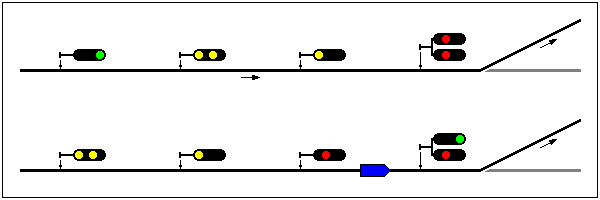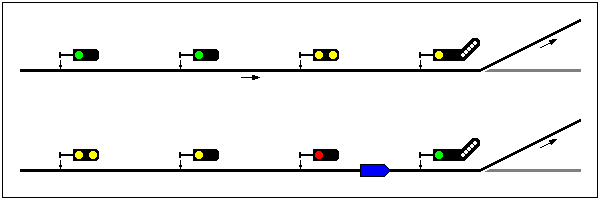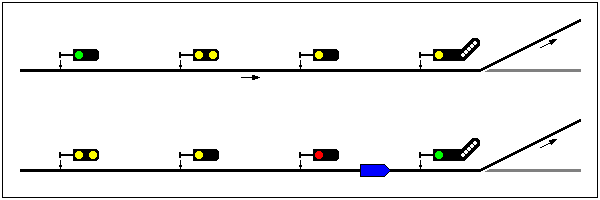|
|
|
This page presents an overview of junction signalling in Britain and its evolution from the days of mechanical signalling. The purpose of junction signalling is to inform drivers approaching a junction of which route their train will take, enabling them to regulate their speed accordingly. A significant reduction in speed may be necessary to safely negotiate a diverging route, and drivers must learn the permissible speed of each route as part of their route knowledge, which is supplemented by lineside speed signs. This is the basis of 'route signalling', as distinct from 'speed signalling' in which the signal aspect tells the driver the permissible speed, without specifying the actual route. Route signalling is characteristic of British railways, whereas most countries around the world now use speed signalling.
In addition to controlling the train's speed, some forms of junction signalling can help prevent mis-routeing by conveying routeing information to the driver early enough for the train to be stopped before reaching the junction if an incorrect route has been set.
Note: All the diagrams on this page illustrate a scenario where a train is being signalled through a left-hand divergence, and they assume that the line is clear throughout and all signals are showing the least restrictive aspect possible in the circumstances. Under less favourable conditions, drivers may encounter signal aspects more restrictive than those illustrated.
The provision of splitting distant signals was a requirement of the Board of Trade until 1914. A semaphore splitting distant signal has separate arms arranged in a similar configuration to the junction signal itself. This gives the driver information about the junction ahead in a complete and unambiguous way, and it allows a normal aspect sequence to be maintained through the junction. Since the splitting distant signal is located at full braking distance from the junction signal, the driver of a wrongly routed train has the opportunity to stop before reaching the junction. Disadvantages of splitting distant signals are that they are expensive to install and can be difficult to sight.

|
| Fig. 1: Semaphore Signalling with Splitting Distant Signal. |
|---|
Where a splitting distant signal is not provided, the distant signal is maintained at 'caution' when a lower-speed diverging route is set. An approaching driver has to start braking because the distant signal being at 'caution' could otherwise mean that the home signal (which might be situated before the junction signal) is at 'danger'. On seeing that the junction signal is 'off', the driver can regulate the speed of the train for the divergence. At some junctions, the lack of a splitting distant signal could be unduly restrictive.

|
| Fig. 2: Semaphore Signalling without Splitting Distant Signal. |
|---|
The earliest colour light junction signals had perpetuated the established practice applicable to semaphore signals, being provided with separate signal heads instead of semaphore arms. The signal heads were positioned side by side, and some were stepped in height in the same manner as semaphore arms. Splitting distant signals were initially considered to be incompatible with three or four-aspect signalling and were not provided. If the permissible speed of the diverging route is equal or close to that of the straight-ahead route, an unrestricted aspect sequence can be given without the need for a splitting distant signal or special signalling controls. The driver is able to reduce speed for the divergence (if necessary) upon sighting the junction signal.

|
| Fig. 3: Colour Light Junction Signal with Separate Heads. |
|---|
Where the permissible speed of the diverging route is significantly lower than that of the straight (i.e. highest speed) route, reduction of speed for a diverging route can be enforced through the application of signalling controls. 'Approach release from red' holds the junction signal at 'danger' until the train is close to it, even though the signalman had earlier set the route through the junction. This has the effect of presenting the driver with an ordinary cautionary aspect sequence on the approach to the junction. The driver has to start a brake application sufficient to be able to stop at the junction signal, which will automatically clear to a 'proceed' aspect as the train approaches. The straight route is not approach released, and an unrestricted aspect sequence can be displayed.

|
| Fig. 4: Approach Release from Red. |
|---|
For divergences with a relatively high permissible speed, approach release from red can be too restrictive. The LNER and the LMS therefore adopted the practice recommended in the IRSE's Three-Position Signalling Committee's report, of displaying a double yellow aspect at the signal on approach to the junction signal when a diverging route was set at the junction ahead. This aspect indicated to the driver that the next signal must be passed at restricted speed. A double yellow aspect could be provided solely for this purpose in areas of otherwise three-aspect signalling, where full braking distance existed between signals.

|
| Fig. 5: Double Yellow Aspect on approach. |
|---|
Colour light splitting distant signals began to be provided in three or four-aspect signalling territory from the early 1930s. These signals allow an unrestricted aspect sequence to be shown for the diverging route as well as for the straight route and avoid the need for approach release.

|
| Fig. 6: Colour Light Splitting Distant Signal. |
|---|
The practice of equipping junction signals with more than one signal head had the undesirable effect of compelling drivers to pass red lights at speed in the normal course of running. The use of a route indicator in conjunction with a single signal head avoided this problem, but the low readability of alphanumeric route indicators makes them unsuitable for high-speed applications. The development of the junction indicator in the mid-1930s offered a form of route indicator that was readable from much greater distances. Approach release or splitting distant signals continued to be provided as necessary to give drivers prior warning of the diverging route.

|
| Fig. 7: Colour Light Junction Signal with Junction Indicator. |
|---|
In early applications of approach release from red, the aspect of the junction signal was released when the train's speed had been reduced to the speed of the divergence. Later installations allowed the aspect to step up as soon as the signal and junction indicator were both visible and readable. Although the train may not yet have decelerated to the speed of the divergence, the driver could see the route indicator and would continue braking accordingly. Before 1987, it was practice to restrict the aspect to single yellow until the train had passed the AWS magnet, so that a 'warning' indication would always be received in the cab for the diverging route, even if the signals ahead were 'clear'. Current practice allows the aspect to be released straight to green as soon as the signal and junction indicator are both visible and readable.
Where approach release from red would be too restrictive, an improvement can be made by approach releasing the junction signal from a yellow aspect rather than red. This is now referred to as 'free yellow'. Free yellow can only be used with a four-aspect sequence, i.e. the signal on approach to the junction signal must be capable of displaying a double yellow aspect. This is to ensure that a driver being routed over the divergence will have passed a signal displaying a cautionary aspect and therefore will have started braking before sighting the junction signal.

|
| Fig. 8: Free Yellow. |
|---|
The superior braking performance of the Class 253 and 254 'High Speed Trains', introduced in 1976, enabled them to begin braking later after passing a double yellow aspect. This revealed a problem with the 'free yellow' form of junction signalling. Drivers of High Speed Trains, having passed the double yellow aspect and thinking they were braking to stop at a red aspect two signals ahead, could suddenly be confronted with a junction signal set for the diverging route and have to brake hard to take the divergence at the correct speed. To remedy this, new flashing yellow signal aspects were introduced from 1979 to give the driver a positive indication that a diverging route was set at the junction ahead. The signal on approach to the junction signal displays a flashing single yellow aspect, meaning that the junction signal is showing a 'proceed' aspect applicable to a diverging route. In four-aspect territory, a flashing single yellow is normally preceded by a flashing double yellow aspect at the previous signal, to present a consistent sequence.
Before 1987, it was practice to restrict the junction signal's aspect to single yellow (or double yellow where that would be too restrictive) until the train had passed the AWS magnet, so that a 'warning' indication would always be received in the cab for the diverging route. Under certain circumstances it will be necessary to revert to approach release from red. Where there is more than one diverging route, the flashing yellow aspects only apply to those with the highest permissible speed. The provision of new splitting distant signals ceased upon the introduction of flashing yellow aspects but was subsequently resumed.

|
| Fig. 9: Approach Release from Yellow with Flashing Aspects on approach. |
|---|
To cater for the installation of new junction layouts that permitted very high turnout speeds, for which flashing yellow aspects would be too restrictive, the splitting distant signal was reintroduced to colour light junction signalling practice in 1992. In three-aspect territory, the splitting distant signal is located at full braking distance from the junction signal. It follows therefore that there must be ample distance for a train to decelerate to the speed of the divergence and, additionally, any train that is wrongly routed will be able to stop before reaching the junction. The same does not necessarily apply to splitting distant signals in four-aspect territory. If the splitting distant was too near the junction to allow the train to decelerate to the speed of the divergence, then the signal on approach to it had to be restricted to a double yellow aspect for the diverging route. The reintroduction of splitting distant signals included provision for a 'preliminary route indicator' (PRI) to be used in four-aspect territory, but only where early routeing information was needed to prevent mis-routeing.

|
| Fig. 10: Splitting Distant Signal and Preliminary Route Indicator. |
|---|
Revised principles introduced in 1996 did away with the PRI and replaced it with the 'outer splitting distant signal'. As with the former PRI, this is only applicable to four-aspect territory. The signal on approach to a splitting distant may be equipped as an outer splitting distant signal where routeing information needs to be given earlier than at the 'inner' splitting distant, either to prevent mis-routeing or to ensure that the diverging route is taken at a safe speed.

|
| Fig. 11: Outer and Inner Splitting Distant Signals. |
|---|
Preliminary route indicators began to reappear in 2002 in conjunction with free yellow, flashing yellow aspects, or at junctions with an unrestricted aspect sequence. These PRIs supplement a compliant junction signalling arrangement, giving advance routeing information only so that mis-routeing can be avoided. One or two PRIs may be provided on the same approach, as circumstances require.

|
| Fig. 12: Preliminary Route Indicators. |
|---|
|